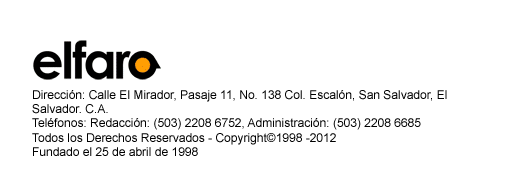POLLS VARY WIDELY BUT MOST SHOW SLIGHT LEAD FOR FMLN
Publicado el 28 de Noviembre de 2011
id: 196566
date: 3/12/2009 14:50
refid: 09SANSALVADOR210
origin: Embassy San Salvador
classification: CONFIDENTIAL
destination:
header:
VZCZCXYZ0021
PP RUEHWEB
DE RUEHSN #0210/01 0711450
ZNY CCCCC ZZH
P 121450Z MAR 09
FM AMEMBASSY SAN SALVADOR
TO RUEHC/SECSTATE WASHDC PRIORITY 0806
INFO RUEHZA/WHA CENTRAL AMERICAN COLLECTIVE PRIORITY
RHEHNSC/NSC WASHINGTON DC PRIORITY
RUEKJCS/SECDEF WASHDC PRIORITY
----------------- header ends ----------------
C O N F I D E N T I A L SAN SALVADOR 000210
SIPDIS
E.O. 12958: DECL: 03/09/2019
TAGS: PGOV, KPLS, KDEM, ES
SUBJECT: POLLS VARY WIDELY BUT MOST SHOW SLIGHT LEAD FOR
FMLN
Classified By: Robert I. Blau, Charge d'Affaires, for reasons 1.4 (b)
and (d)
1. (C) Summary: The majority of polls released before the
15-day ban on poll publication prior to the March 15 election
show (left-wing) Farabundo Marti National Liberation Front
(FMLN) presidential candidate Mauricio Funes leading
(conservative, pro-U.S.) Nationalist Republican Alliance
(ARENA) candidate Rodrigo Avila in a close race. Polls
conducted in El Salvador are of varying quality and
methodological soundness, and some firms have political
affiliations that may influence their results. Poloffs met
four polling firms and observed methodological differences
and some unsound practices. The firms gave varied
explanations for the failure of many polling firms to predict
the outcome of San Salvador's January 18 municipal race, but
the number of voters bused in from outside San Salvador,
mentioned by several firms, may have been a factor. End
Summary.
--------------------------------------
MOST POLLS SHOW FUNES WITH NARROW LEAD
--------------------------------------
2. (C) Media outlets released a flurry of polls before El
Salvador entered the 15-day period prior to the March 15
presidential election, during which, by law, polls cannot be
published. Most data show FMLN presidential candidate
Mauricio Funes slightly ahead in a close race. The majority
of the polls reveal a narrow gap between the two candidates,
and several show a statistical tie (the percentage point
difference between the candidates is smaller than the margin
of error). Two polls indicate that ARENA presidential
candidate Rodrigo Avila is ahead, and a few outliers show
Funes maintaining a double-digit lead over Avila. A sizeable
amount of the electorate (approximately 12 to 20 percent)
remains undecided; the withdrawal of the (center-right)
Christian Democratic Party (PDC) and the (right-wing,
opportunistic) National Conciliation Party (PCN) from the
race appears to have given ARENA a moderate boost.
Firm Dates ARENA FMLN Diff. Margin of
Error
Borge 2/16-22 40.9 40.0 0.9 2.8 (stat. tie)
CID-Gallup 2/28-3/2 38.3 43.6 5.3 3.0
----
CIOPS 2/20-22 48.9 50.5 1.6 2.8
(stat.tie)
COP 2/11-15 29.6 37.5 7.9 2.0-2.5
----
CS-Sondea 2/5-13 30.1 41.3 11.2 unknown
----
Jabes 2/20-23 42.5 39.0 3.5 2.5
----
LPG Datos 2/20-23 28.0 30.9 2.9 2.2
----
Meba 2/20-22 41.5 44.5 3.0 2.9
----
Mitofsky Feb 40.1 40.8 0.7 unkn (stat. tie)
UCA-IUDOP 2/1-15 31.7 49.3 17.6 1.95
----
Vox-Latina 2/8-13 28.5 48.6 20.1 3.7
----
Note: Leads outside of the margin of error are underlined.
-----------------------------------------
POLLS' RELIABILITY AND METHODOLOGY DIFFER
-----------------------------------------
3. (C) The reliability and methodology used by the firms
conducting polls in El Salvador varies widely, which poloffs
confirmed when meeting with three universities and a
newspaper that conduct polls. The wide variation in the
polls for the March 15 election can be largely explained by
differences in methodology and by the dates spanned by the
polling. Meetings with La Prensa Grafica's LPG Datos,
Francisco Gavidia's Center of Public Opinion (COP), the
Technological University's Center of Public Opinion of the
Salvadoran Population (CIOPS), and the Central American
University's Institute of Public Opinion (IUDOP) revealed
that polling firms construct their samples differently, use
different wording and order in their questions, and employ
different methods (some of which did not appear to be
statistically sound) to reach out to respondents. In
addition, the date of polls conducted in February is
important; polls conducted following the withdrawal of the
PDC and PCN and the decisions of the leaders of these parties
to endorse ARENA show a modest increase in Avila's numbers.
--------------------------------------------- ---
POLLING FIRMS' REPUTATIONS AND AFFILIATIONS VARY
--------------------------------------------- ---
4. (C) Many of the firms operating in El Salvador are
contracted by newspapers, universities, and the political
parties, which affects how their results are presented and,
potentially, the firms' independence. For example, both
presidential candidates claim that their internal polls show
them ahead. CS-Sondea, which shows a double-digit lead for
Funes, is owned by a consultant of Funes', and conducts polls
for the candidate. Vox Latina, which also shows a
double-digit Funes lead, is a Guatemalan firm contracted by
the FMLN. Mitofsky, which shows a tie, works with
Telecorporacion Salvadorena (TCS), a right-leaning entity.
Borge and Asociados, which has a poor reputation regionally,
and Jabes Market Research conducted their recent polls
showing Avila slightly up on behalf of (right-wing) newspaper
El Diario de Hoy. Double-digit leads for Funes in the
university polls may be the result of poor methodology and,
possibly, left-leaning slant. On the other hand, CID-Gallup,
which shows Funes up by five points, is a prestigious and
reputable polling firm in Latin America. CID-Gallup released
poll numbers prior to El Salvador's 2004 presidential
elections that were very close to the actual electoral
results.
--------------------------------------------- -
LPG DATOS' CANDID TAKE ON DIFFERENCES IN POLLS
--------------------------------------------- -
5. (C) Edwin Segura of LPG Datos, which appeared to be the
most competent and responsible polling firm out of the four,
was frank about the difficulties in carrying out polls in El
Salvador and explained common methodological discrepancies.
Segura said that the poor can be difficult to access because
they live in dangerous areas, while the well-off are also
hard to access because they live in walled-off residences.
He lamented the difficulty in getting accurate demographic
data in El Salvador to use for building polling samples and
asserted that Salvadoran institutions often release incorrect
statistics. Segura pointed out that several polling firms
are not working from the most recent 2007 census, and that
the firms use different rural-to-urban and male-to-female
proportions in their samples. For example, he said that
Borge and Mitofsky use the 1992 census proportion of
rural-to-urban populations for their samples, while others
use the 2007 census figures, and LPG Datos uses its own
adjustment to the rural-to-urban proportion from the 2007
census. Differences in rural-to-urban and male-to-female
proportions could cause the results to favor one party over
the other; according to some pollsters, ARENA draws support
from the rural poor and housewives, while FMLN voters tend to
be urban and male.
---------------------------------------------
POLLING FIRMS DESCRIBE QUESTIONABLE PRACTICES
---------------------------------------------
6. (C) All of the firms admitted to some practices that
appeared methodologically unsound during the meetings, but
the universities accounted for the worst practices.
Francisco Armando Zepeda of CIOPS explained that the firm
attempted to reach wealthy voters by conducting polls at
places frequented by the well-off like commercial centers,
supermarkets, and gas stations; this method of sampling is
not random nor an accurate measure of income level. Zepeda
also described how if his workers came to a house displaying
party propaganda that they would throw it out of the sample,
again creating a sample that is no longer random. Jeannette
Aguilar of IUDOP appeared to lack confidence in IUDOP's poll
and confided that, although the poll shows a double-digit
lead, she thought the race would be close.
--------------------------------------------- -----
EXTERIOR VOTERS MAY HAVE THROWN SAN SALVADOR POLLS
--------------------------------------------- -----
7. (C) Several firms attributed the failure of at least six
polling firms to accurately predict the outcome of San
Salvador,s mayoral race to votes from individuals residing
outside of the capital. (Salvadorans vote by place of
registration, not by their current place of residence).
Segura said the disparity between the polls and the results
suggested some type of fraud or voter manipulation, but he
questioned the validity of the polling from IUDOP and CIOPS,
which was off by double digits. Zepeda admitted that CIOPS
probably made a mistake in their sample and that some voters
changed their minds but asserted that voters from outside of
San Salvador also were a factor. Elner Crespin of COP
pointed out that their polling matched results in key
municipal races besides San Salvador. He said that survey
respondents attributed votes from outside San Salvador, the
ARENA candidate,s perceived competence, and the ARENA
metrobus proposal as top factors in the San Salvador outcome.
8. (C) Comment: Although Funes appears to have the edge in
credible poll numbers (CID-Gallup, LPG Datos), the race is
too close to call. Given the disparities in polling
methodology and the apparent ideological bias of many of the
local firms, we will only be able to judge the accuracy of
the polling after the March 15 election. Voter migration
within El Salvador may have thrown off the January 18 polling
data; voters returning home to vote on March 15 (mostly from
the U.S.) could similarly throw off the presidential election
polling. End Comment.
BLAU
=======================CABLE ENDS============================




